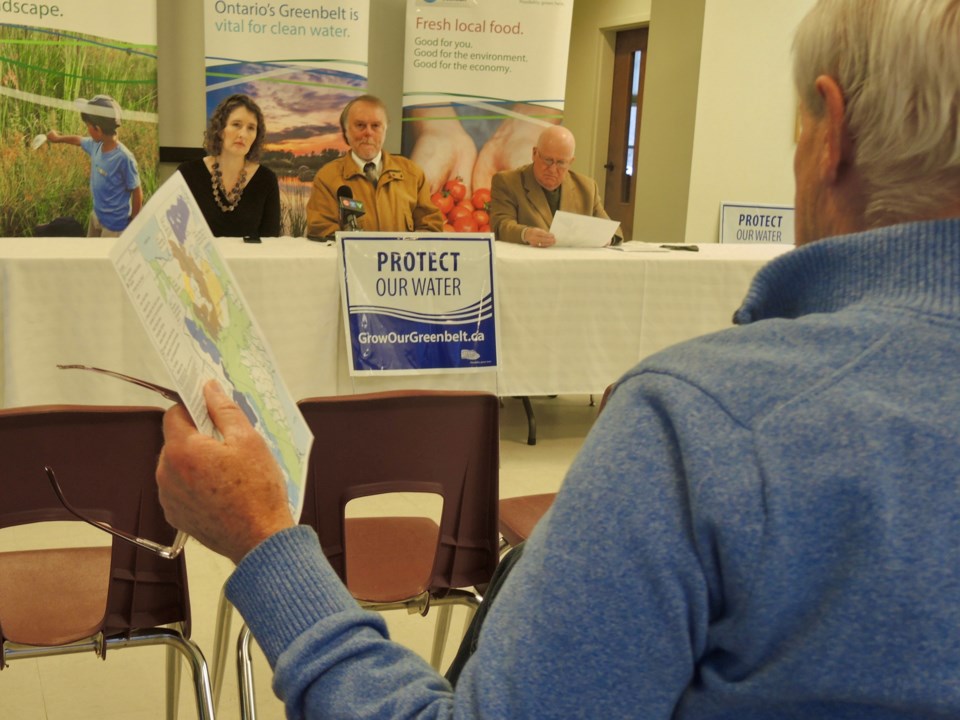A local coalition is applauding the province's move to preserve drinking water resources by expanding a protected area known as the Greenbelt.
There are many areas of Simcoe County that could potentially be included in the Greenbelt according to a draft map, such as the Oro Moraine, aquifer complexes, river corridors and provincially significant wetlands.
The Simcoe County Greenbelt Coalition held a news conference at St. Thomas' Anglican Church in Shanty Bay Thursday to react to the government's announcement and issue a call to action for residents.
Over the next 90 days, Ontario is looking for public input on the Greenbelt expansion and will hold public open houses in several locations across the study area.
"We are very happy with today's announcement that the province is starting this process. That they're taking the water quantity and quality of Simcoe County and other areas seriously," said Margaret Prophet, Executive Director of SCGC,
Prophet says people take water for granted but it's a finite resource.
"My call to action is do not think that your water is going to stand up for itself. It needs our help. It needs our voice and it needs our action. So if you drink water, you need to be involved."
Currently, Ontario’s Greenbelt spans 1.8 million acres but mostly avoids Simcoe County. Expanding the Greenbelt over these sensitive and significant water resources would be a needed first step in securing our clean water supplies for future generations, according to the coalition.
"It's greatly overdue as far as I'm concerned," said Bernard Pope, Simcoe County Farmer and Chair of Ontario Farmland Trust. "The government is listening to us."
Springwater Mayor Bill French welcomed the chance to preserve sensitive areas which would help protect farmland and respect First Nations' rights.
"I think it's a really good start. As long as we come up with some teeth in the policies," French said, adding that defining the Greenbelt will simplify development decisions because in a Greenbelt 'you cant go there.'
The downsides according to the panel are the fact that two-thirds of the shoreline of Lake Simcoe are not included in the study area and the proposed area is too small.
In the next 25 years, the Greater Golden Horseshoe’s population is forecasted to grow by approximately 50% or more than 4 million people. This growth will place tremendous pressure on our water resources, according to the government.
"This is a major step forward to ensure the viability of farms and farmland as well as food security in the province," said Pope.
Ontario is seeking public input on seven areas whose water the province deems most in need of protection, including moraines, cold water streams and wetlands in the outer ring of the Greater Golden Horseshoe.
About 10,000 hectares were added to the Greenbelt this year, which the government says include 21 new urban river valleys and associated coastal wetland areas that connect to Lake Ontario.
The study area is based on the locations in the outer ring with the highest concentrations of important water resources under pressure from current or forecasted urban growth. The study area was identified based on the locations of important “building blocks” features: moraines and other sand and gravel areas, coldwater streams and wetlands. It is made up of the following seven features and areas:
- The Waterloo and Paris/Galt moraine complex in Waterloo Region, and Brant and Wellington counties.
- The Orangeville Moraine in Wellington and Dufferin counties.
- Several small moraines, including the Gibraltar and Singhampton moraines, along the brow of the Niagara Escarpment in Dufferin and Simcoe counties.
- The Oro Moraine in northeast Simcoe County.
- The Nottawasaga River corridor in Dufferin and Simcoe counties.
- Important surface water and recharge features in southeast Simcoe County.
- Catchment areas and wetlands west of Minesing in Dufferin and Simcoe counties.
The first stage - the study stage - will go to March 7, 2018.
For more information about the consultation go to this site.



